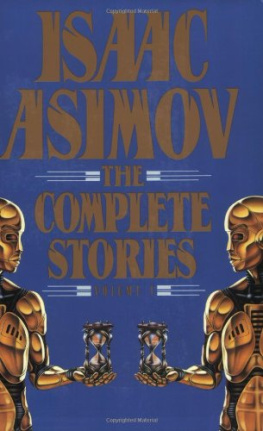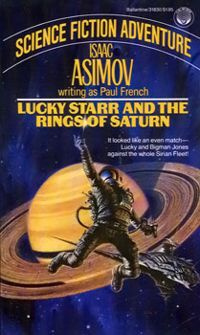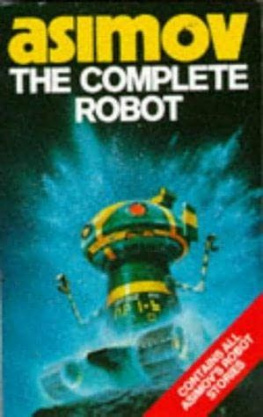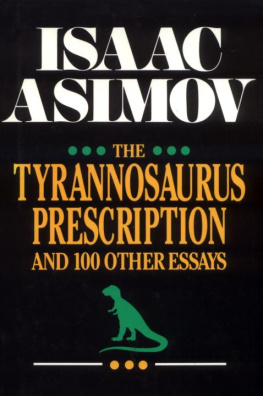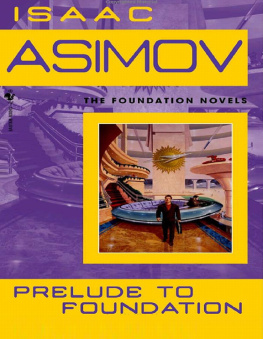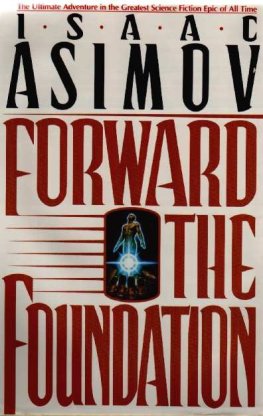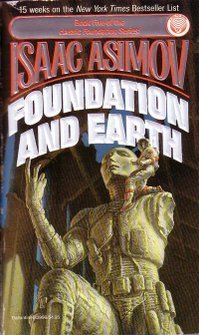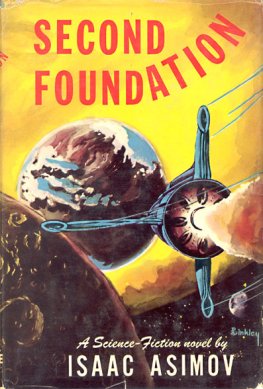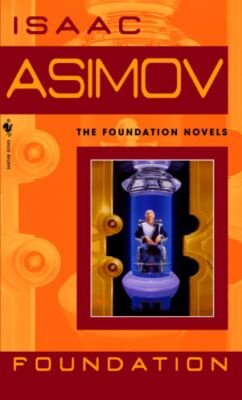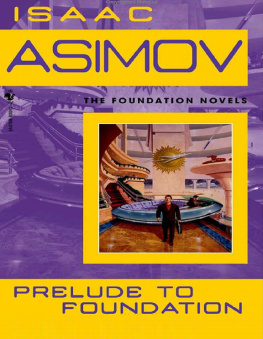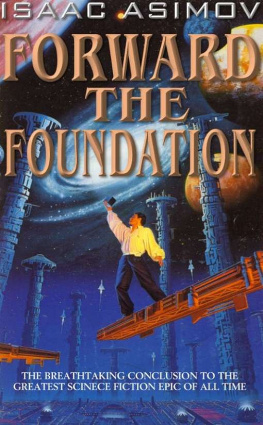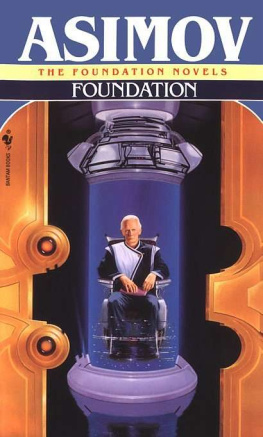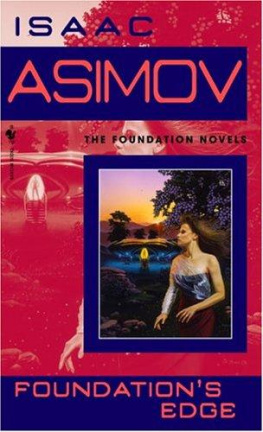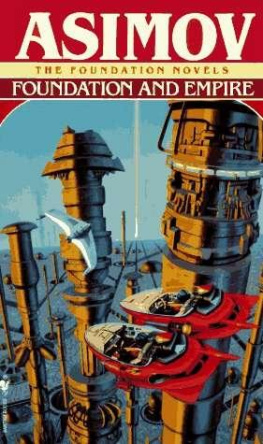Isaac Asimov - Foundation 4 Foundation and Empire
Here you can read online Isaac Asimov - Foundation 4 Foundation and Empire full text of the book (entire story) in english for free. Download pdf and epub, get meaning, cover and reviews about this ebook. year: 1991, publisher: Spectra, genre: Detective and thriller. Description of the work, (preface) as well as reviews are available. Best literature library LitArk.com created for fans of good reading and offers a wide selection of genres:
Romance novel
Science fiction
Adventure
Detective
Science
History
Home and family
Prose
Art
Politics
Computer
Non-fiction
Religion
Business
Children
Humor
Choose a favorite category and find really read worthwhile books. Enjoy immersion in the world of imagination, feel the emotions of the characters or learn something new for yourself, make an fascinating discovery.

- Book:Foundation 4 Foundation and Empire
- Author:
- Publisher:Spectra
- Genre:
- Year:1991
- Rating:4 / 5
- Favourites:Add to favourites
- Your mark:
- 80
- 1
- 2
- 3
- 4
- 5
Foundation 4 Foundation and Empire: summary, description and annotation
We offer to read an annotation, description, summary or preface (depends on what the author of the book "Foundation 4 Foundation and Empire" wrote himself). If you haven't found the necessary information about the book — write in the comments, we will try to find it.
Foundation 4 Foundation and Empire — read online for free the complete book (whole text) full work
Below is the text of the book, divided by pages. System saving the place of the last page read, allows you to conveniently read the book "Foundation 4 Foundation and Empire" online for free, without having to search again every time where you left off. Put a bookmark, and you can go to the page where you finished reading at any time.
Font size:
Interval:
Bookmark:
FOUNDATION AND EMPIRE
ISAAC ASIMOV
Contents
PART I THE GENERAL
PART II THE MULE
THE STORY BEHIND THE "FOUNDATION"
By ISAAC ASIMOV
The date was August 1, 1941. World War II had been raging for two years. France had fallen, the Battle of Britain had been fought, and the Soviet Union had just been invaded by Nazi Germany. The bombing of Pearl Harbor was four months in the future.
But on that day, with Europe in flames, and the evil shadow of Adolf Hitler apparently falling over all the world, what was chiefly on my mind was a meeting toward which I was hastening.
I was 21 years old, a graduate student in chemistry at Columbia University, and I had been writing science fiction professionally for three years. In that time, I had sold five stories to John Campbell, editor of Astounding, and the fifth story, "Nightfall," was about to appear in the September 1941 issue of the magazine. I had an appointment to see Mr. Campbell to tell him the plot of a new story I was planning to write, and the catch was that I had no plot in mind, not the trace of one.
I therefore tried a device I sometimes use. I opened a book at random and set up free association, beginning with whatever I first saw. The book I had with me was a collection of the Gilbert and Sullivan plays. I happened to open it to the picture of the Fairy Queen of lolanthe throwing herself at the feet of Private Willis. I thought of soldiers, of military empires, of the Roman Empire of a Galactic Empire aha!
Why shouldn't I write of the fall of the Galactic Empire and of the return of feudalism, written from the viewpoint of someone in the secure days of the Second Galactic Empire? After all, I had read Gibbon's Decline and Fall of the Roman Empire not once, but twice.
I was bubbling over by the time I got to Campbell's, and my enthusiasm must have been catching for Campbell blazed up as I had never seen him do. In the course of an hour we built up the notion of a vast series of connected stories that were to deal in intricate detail with the thousand-year period between the First and Second Galactic Empires. This was to be illuminated by the science of psychohistory, which Campbell and I thrashed out between us.
On August 11, 1941, therefore, I began the story of that interregnum and called it "Foundation." In it, I described how the psychohistorian, Hari Seldon, established a pair of Foundations at opposite ends of the Universe under such circumstances as to make sure that the forces of history would bring about the second Empire after one thousand years instead of the thirty thousand that would be required otherwise.
The story was submitted on September 8 and, to make sure that Campbell really meant what he said about a series, I ended "Foundation" on a cliff-hanger. Thus, it seemed to me, he would be forced to buy a second story.
However, when I started the second story (on October 24), I found that I had outsmarted myself. I quickly wrote myself into an impasse, and the Foundation series would have died an ignominious death had I not had a conversation with Fred Pohl on November 2 (on the Brooklyn Bridge, as it happened). I don't remember what Fred actually said, but, whatever it was, it pulled me out of the hole.
"Foundation" appeared in the May 1942 issue of Astounding and the succeeding story, "Bridle and Saddle," in the June 1942 issue.
After that there was only the routine trouble of writing the stories. Through the remainder of the decade, John Campbell kept my nose to the grindstone and made sure he got additional Foundation stories.
"The Big and the Little" was in the August 1944 Astounding, "The Wedge" in the October 1944 issue, and "Dead Hand" in the April 1945 issue. (These stories were written while I was working at the Navy Yard in Philadelphia.)
On January 26, 1945, I began "The Mule," my personal favorite among the Foundation stories, and the longest yet, for it was 50,000 words. It was printed as a two-part serial (the very first serial I was ever responsible for) in the November and December 1945 issues. By the time the second part appeared I was in the army.
After I got out of the army, I wrote "Now You See It" which appeared in the January 1948 issue. By this time, though, I had grown tired of the Foundation stories so I tried to end them by setting up, and solving, the mystery of the location of the Second Foundation. Campbell would have none of that, however. He forced me to change the ending, and made me promise I would do one more Foundation story.
Well, Campbell was the kind of editor who could not be denied, so I wrote one more Foundation story, vowing to myself that it would be the last. I called it "And Now You Don't," and it appeared as a three-part serial in the November 1949, December 1949, and January 1950 issues of Astounding.
By then, I was on the biochemistry faculty of Boston University School of Medicine, my first book had just been published, and I was determined to move on to new things. I had spent eight years on the Foundation, written nine stories with a total of about 220,000 words. My total earnings for the series came to $3,641 and that seemed enough. The Foundation was over and done with, as far as I was concerned.
In 1950, however, hardcover science fiction was just coming into existence. I had no objection to earning a little more money by having the Foundation series reprinted in book form. I offered the series to Doubleday (which had already published a science-fiction novel by me, and which had contracted for another) and to Little-Brown, but both rejected it. In that year, though, a small publishing firm, Gnome Press, was beginning to be active, and it was prepared to do the Foundation series as three books.
The publisher of Gnome felt, however, that the series began too abruptly. He persuaded me to write a small Foundation story, one that would serve as an introductory section to the first book (so that the first part of the Foundation series was the last written).
In 1951, the Gnome Press edition of Foundation was published, containing the introduction and the first four stories of the series. In 1952, Foundation and Empire appeared, with the fifth and sixth stories; and in 1953, Second Foundation appeared, with the seventh and eighth stories. The three books together came to be called The Foundation Trilogy.
The mere fact of the existence of the Trilogy pleased me, but Gnome Press did not have the financial clout or the publishing knowhow to get the books distributed properly, so that few copies were sold and fewer still paid me royalties. (Nowadays, copies of first editions of those Gnome Press books sell at $50 a copy and upbut I still get no royalties from them.)
Ace Books did put out paperback editions of Foundation and of Foundation and Empire, but they changed the titles, and used cut versions. Any money that was involved was paid to Gnome Press and I didn't see much of that. In the first decade of the existence of The Foundation Trilogy it may have earned something like $1500 total.
And yet there was some foreign interest. In early 1961, Timothy Seldes, who was then my editor at Doubleday, told me that Doubleday had received a request for the Portuguese rights for the Foundation series and, since they weren't Doubleday books, he was passing them on to me. I sighed and said, "The heck with it, Tim. I don't get royalties on those books."
Seldes was horrified, and instantly set about getting the books away from Gnome Press so that Doubleday could publish them instead. He paid no attention to my loudly expressed fears that Doubleday "would lose its shirt on them." In August 1961 an agreement was reached and the Foundation books became Doubleday property. What's more, Avon Books, which had published a paperback version of
Next pageFont size:
Interval:
Bookmark:
Similar books «Foundation 4 Foundation and Empire»
Look at similar books to Foundation 4 Foundation and Empire. We have selected literature similar in name and meaning in the hope of providing readers with more options to find new, interesting, not yet read works.
Discussion, reviews of the book Foundation 4 Foundation and Empire and just readers' own opinions. Leave your comments, write what you think about the work, its meaning or the main characters. Specify what exactly you liked and what you didn't like, and why you think so.


